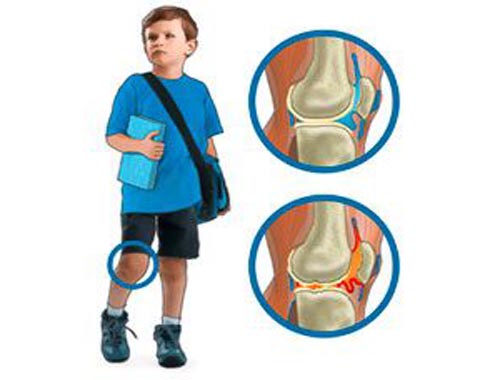Juvenile Rheumatoid Arthritis; JRA; Juvenile Idiopathic Arthritis; JIA; Juvenile chronic arthritis; JCA
Juvenile rheumatoid arthritis consists of joint inflammation and stiffness for more than six weeks in a child aged 16 or younger. Inflammation causes redness, swelling, warmth, and soreness in the joints. Still, many children with JRA do not complain of joint pain. Any joint can be affected with JRA. The ongoing inflammation may limit the mobility of affected joints. JRA is an autoimmune disorder. This means that the body mistakenly identifies some of its own cells and tissues as foreign. Normally, the immune system fights off harmful, foreign substances such as bacteria or viruses. With JRA, the immune system attacks healthy cells and tissues. The result is inflammation -- marked by redness, heat, pain, and swelling. Researchers don't know exactly why the immune system goes awry in children with JRA. They suspect that it's a two-step process. First, something in a child's genetic makeup gives them a tendency to develop JRA. Then an environmental factor, such as a virus, triggers the development of JRA. The main difference between juvenile and adult rheumatoid arthritis is that some people with JRA outgrow the illness. Adults with RA usually have lifelong symptoms. Studies show that by adulthood, JRA symptoms disappear in more than half of all affected children. Another difference between JRA and adult rheumatoid arthritis is the percentage of people who have rheumatoid factor in their blood. The presence of rheumatoid factor indicates an increased chance that JRA will continue into adulthood. About 70% to 80% of adults with rheumatoid arthritis have rheumatoid factor. However, fewer than half of all children with rheumatoid arthritis have rheumatoid factor. Besides joint pain, JRA may cause chronic fever and anemia. It can affect the heart, lungs, eyes, and nervous system. These episodes may last for several weeks. The arthritis flares often recur, but the symptoms may be less severe in recurrent attacks. Symptoms of JRA may include: Repetitive fevers of 103 degrees or higher; Pink rash that comes and goes; Eye inflammation; Joint pain and-or stiffness; Limping; Joint swelling; Reduced activity levels; Decreased activity level; Weakening of fine motor skills; Impaired bone development and growth
